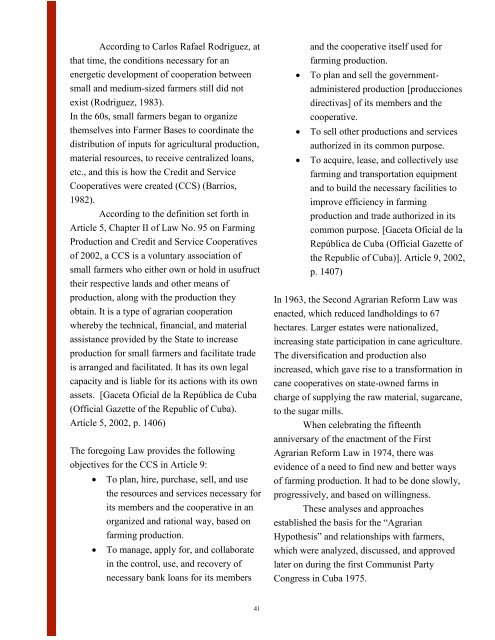CLC-Conference-Proceeding-2018
You also want an ePaper? Increase the reach of your titles
YUMPU automatically turns print PDFs into web optimized ePapers that Google loves.
According to Carlos Rafael Rodriguez, at<br />
that time, the conditions necessary for an<br />
energetic development of cooperation between<br />
small and medium-sized farmers still did not<br />
exist (Rodriguez, 1983).<br />
In the 60s, small farmers began to organize<br />
themselves into Farmer Bases to coordinate the<br />
distribution of inputs for agricultural production,<br />
material resources, to receive centralized loans,<br />
etc., and this is how the Credit and Service<br />
Cooperatives were created (CCS) (Barrios,<br />
1982).<br />
According to the definition set forth in<br />
Article 5, Chapter II of Law No. 95 on Farming<br />
Production and Credit and Service Cooperatives<br />
of 2002, a CCS is a voluntary association of<br />
small farmers who either own or hold in usufruct<br />
their respective lands and other means of<br />
production, along with the production they<br />
obtain. It is a type of agrarian cooperation<br />
whereby the technical, financial, and material<br />
assistance provided by the State to increase<br />
production for small farmers and facilitate trade<br />
is arranged and facilitated. It has its own legal<br />
capacity and is liable for its actions with its own<br />
assets. [Gaceta Oficial de la República de Cuba<br />
(Official Gazette of the Republic of Cuba).<br />
Article 5, 2002, p. 1406)<br />
The foregoing Law provides the following<br />
objectives for the CCS in Article 9:<br />
<br />
<br />
To plan, hire, purchase, sell, and use<br />
the resources and services necessary for<br />
its members and the cooperative in an<br />
organized and rational way, based on<br />
farming production.<br />
To manage, apply for, and collaborate<br />
in the control, use, and recovery of<br />
necessary bank loans for its members<br />
<br />
<br />
<br />
and the cooperative itself used for<br />
farming production.<br />
To plan and sell the governmentadministered<br />
production [producciones<br />
directivas] of its members and the<br />
cooperative.<br />
To sell other productions and services<br />
authorized in its common purpose.<br />
To acquire, lease, and collectively use<br />
farming and transportation equipment<br />
and to build the necessary facilities to<br />
improve efficiency in farming<br />
production and trade authorized in its<br />
common purpose. [Gaceta Oficial de la<br />
República de Cuba (Official Gazette of<br />
the Republic of Cuba)]. Article 9, 2002,<br />
p. 1407)<br />
In 1963, the Second Agrarian Reform Law was<br />
enacted, which reduced landholdings to 67<br />
hectares. Larger estates were nationalized,<br />
increasing state participation in cane agriculture.<br />
The diversification and production also<br />
increased, which gave rise to a transformation in<br />
cane cooperatives on state-owned farms in<br />
charge of supplying the raw material, sugarcane,<br />
to the sugar mills.<br />
When celebrating the fifteenth<br />
anniversary of the enactment of the First<br />
Agrarian Reform Law in 1974, there was<br />
evidence of a need to find new and better ways<br />
of farming production. It had to be done slowly,<br />
progressively, and based on willingness.<br />
These analyses and approaches<br />
established the basis for the “Agrarian<br />
Hypothesis” and relationships with farmers,<br />
which were analyzed, discussed, and approved<br />
later on during the first Communist Party<br />
Congress in Cuba 1975.



